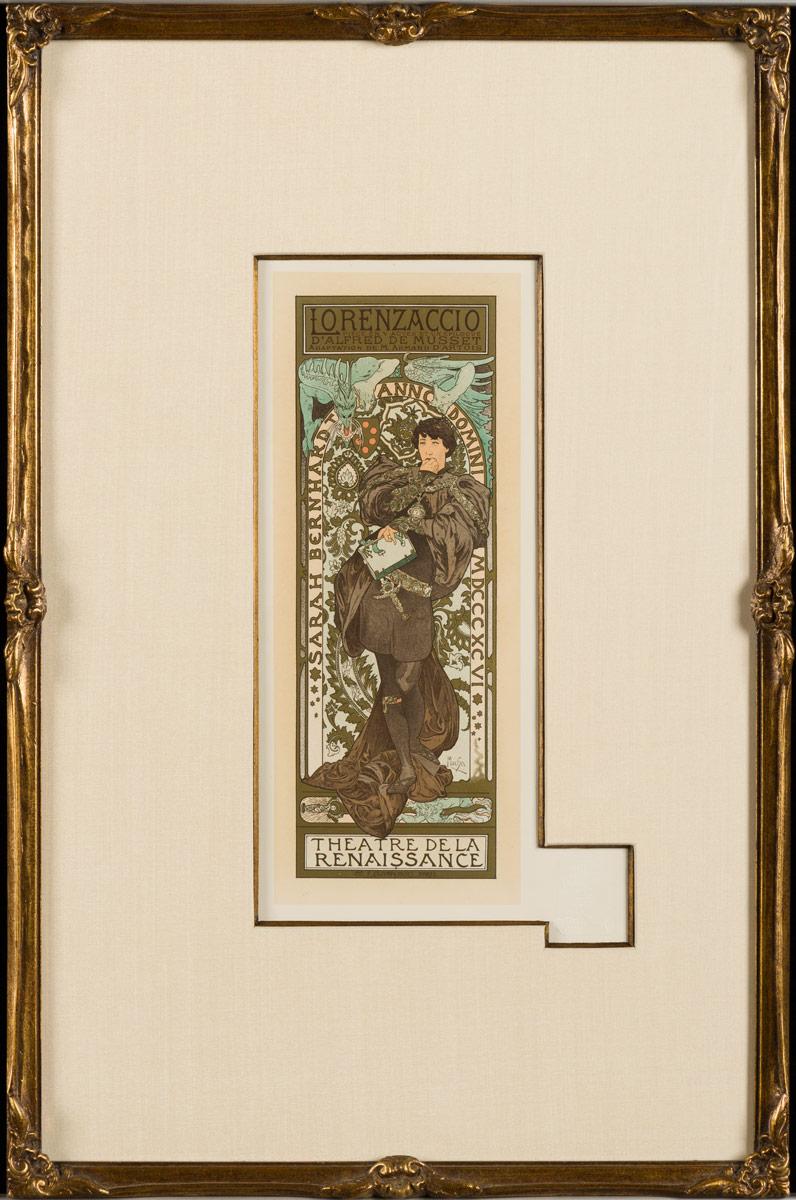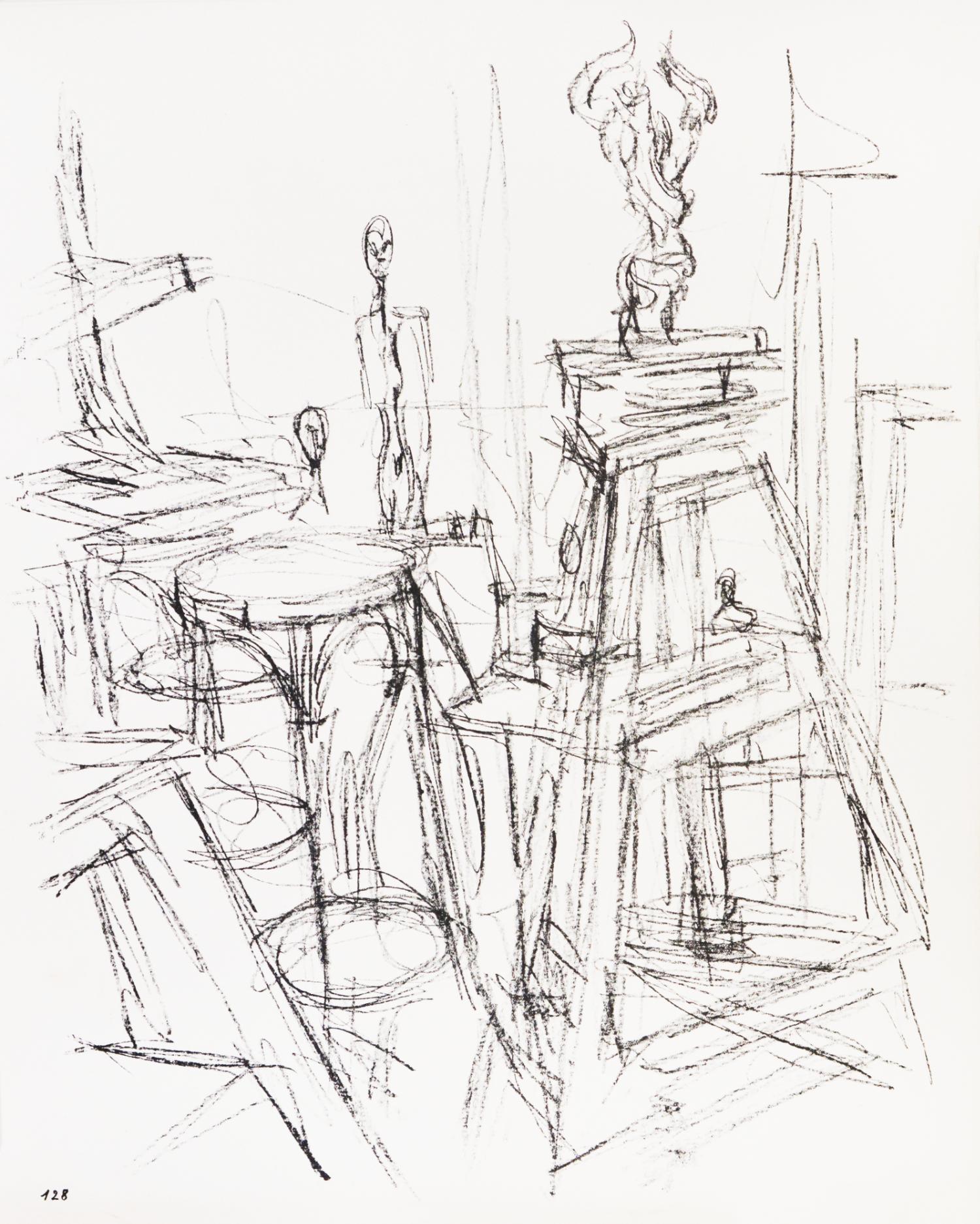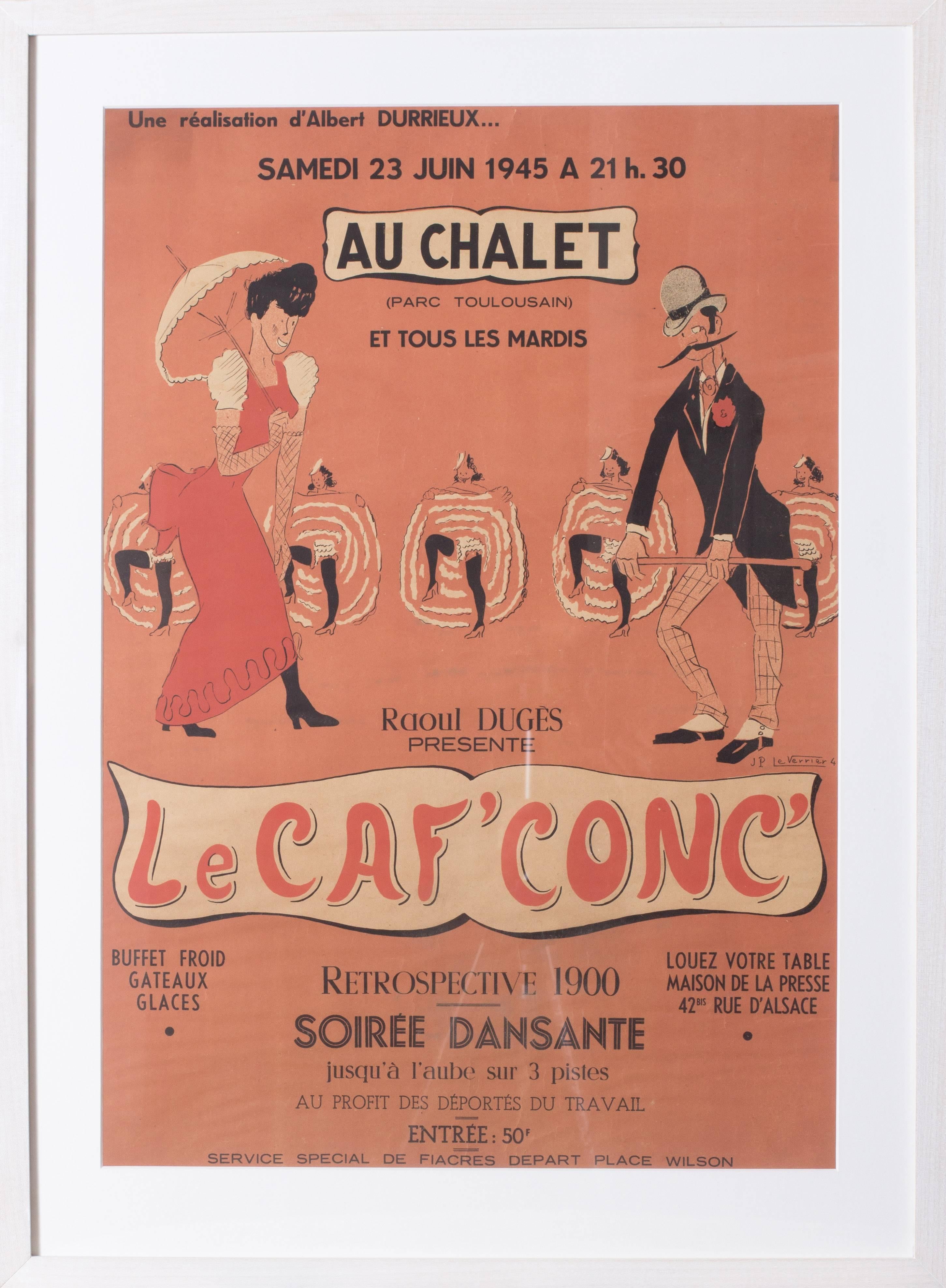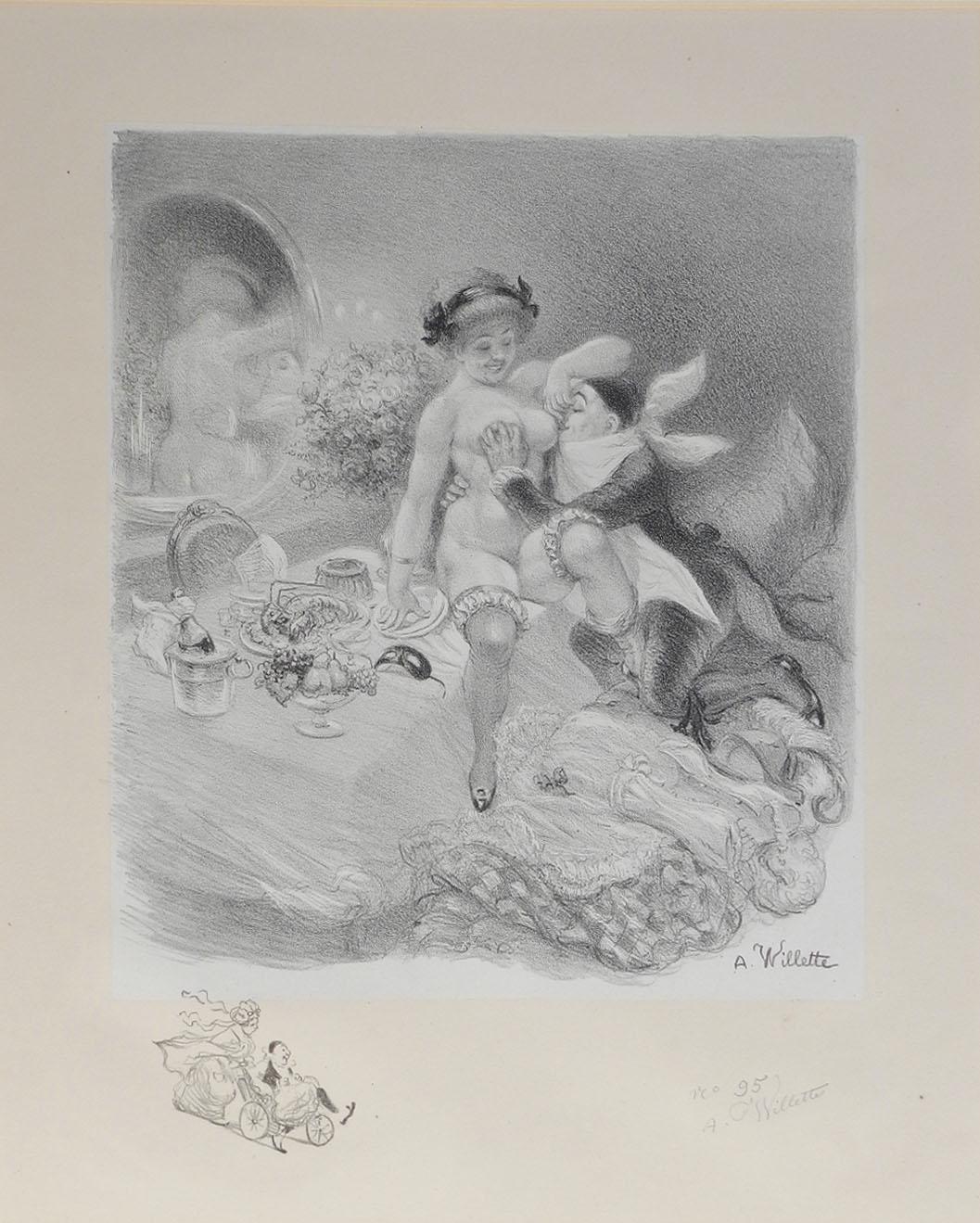Items Similar to Femme Sous la Lampe (Woman Under the Lamp) signed lithograph; József Rippl-Rónai
Want more images or videos?
Request additional images or videos from the seller
József Rippl-RónaiFemme Sous la Lampe (Woman Under the Lamp) signed lithograph; József Rippl-Rónai1894-1895
1894-1895
About the Item
Framed lithograph, signed ("Rónai") and numbered ("no. 50") by the artist. Also includes a silver József Rippl-Rónai coin, made in 1977 for the 50th anniversary of his death.
The lithograph Femme Sous la Lampe (Woman Under the Lamp) marked the original print debut of its creator, József Rippl-Rónai, as well as the height of the color print revival in France during the 1890s. Commissioned by La Revue Blanche, a groundbreaking journal based in Paris, the print also indicates the close connection that existed between avant-garde visual artists and their literary counterparts in fin de siècle France. Indeed some of the most experimental visual artists of the Post-Impressionist period, the Nabis, regularly contributed prints to La Revue Blanche, which gathered a dozen of these into a collectors’ portfolio, L’Album de la Revue Blanche, published in late 1894 or early 1895. Rippl-Rónai became the only central European artist to contribute a print to this prestigious project: Femme Sous la Lampe was that print. The print first appeared in Issue 34 (August 1894). And was reissued in L’Album de la Revue Blanche, which consisted of twelve loose prints, published in an edition of 50 numbered and signed copies. Writing in 1948, Thadée Nantanson noted that the album had become quite rare.
Jozsef Rippl-Ronai was born in Kaposvar, Hungary in 1861. He earned a diploma in pharmacology from the University of Budapest in 1881, but subsequently decided to become an artist. After preliminary training ant the Munich Academy of Fine Arts, he received a grant from the Hungarian National Council for the Fine Arts to study etching in Paris, where he arrived in March, 1887. In September of that year, he received additional funds to learn other printing techniques. Clearly the Hungarian government subsidized Rippl-Ronai as a printmaker as well as a painter, a remarkable prescient decision given the emergence of the peintre-graveur (painter-etcher) in the coming decade. The promising young artists’ international success would enhance the nation’s cultural prestige, and Paris, art capital of the world, was the logical place for him to forge a career.
- Creator:József Rippl-Rónai (1861 - 1927, Hungarian)
- Creation Year:1894-1895
- Dimensions:Height: 7.65 in (19.44 cm)Width: 6 in (15.24 cm)
- Medium:
- Movement & Style:
- Period:
- Condition:
- Gallery Location:Chicago, IL
- Reference Number:1stDibs: LU467313414242

About the Seller
5.0
Gold Seller
These expertly vetted sellers are highly rated and consistently exceed customer expectations.
Established in 2013
1stDibs seller since 2016
83 sales on 1stDibs
Typical response time: 2 hours
- ShippingRetrieving quote...Ships From: Chicago, IL
- Return PolicyA return for this item may be initiated within 3 days of delivery.
More From This SellerView All
- The JockeyBy Henri de Toulouse-LautrecLocated in Chicago, ILColor lithograph on Chine volant, 1899. Edition of aproximately 112. Printed by H. Stern, Paris. Published by Pierrefort, Paris. Reference: Wittrock; 308-2nd edition, vol. 2, pg. 6...Category
1890s Art Nouveau Figurative Prints
MaterialsLithograph
- "Princess Hyacinthe" Original 1911 Lithograph, Alphonse MuchaBy Alphonse MuchaLocated in Chicago, IL“One of Mucha’s best Czech posters, printed by the firm of V. Neubert in the Smichov quarter of Prague, was for Princezna Hyacinta, a fairy-tale ballet and pantomime with music by Oskar Nedbal and libretto by Ladislav Novák. The portrait of the popular actress Andula Sedlácková as the princess dominates the poster. The plot develops as a dream of a village blacksmith who falls asleep after digging for a buried treasure. In his dreams he becomes lord of a castle, and his daughter Hanicka becomes the Princess Hyacinth. Of her three suitors, one is a sorcerer who abducts her to his underground palace, but she is rescued by a poor knight who looks like her real-life lover. Mucha used the motif of the hyacinth throughout the entire design, from embroideries to silver jewelry, and for an elaborate circle sparkling against the mossy green background. The portrait of the actress is seen against a sky full of stars and encircled with images from the dream: the blacksmith’s tools...Category
1910s Art Nouveau Figurative Prints
MaterialsLithograph
- "Bénédictine" Original 1898 Lithograph, Alphonse MuchaBy Alphonse MuchaLocated in Chicago, ILPublished by F. Champenois, Paris. "Bénédictine shows two girls pressing flowers amid book leaves, to remind us of the herbs that go into making the liqueur; the bottom part of the poster has a panorama of the Fecamp Abbey where the drink originated. Around 1510, one of the monks, Dom Bernardo Vincelli, prepared a liqueur using local wine and native herbs found in nearby woods, together with a few imported ingredients including muscat, ginger, clove and cardamom" (Wine Spectator, 70). As with all poster this size, the lithograph was made, in color, on two panels and joined at the center. Alphonse Mucha was a painter and decorative artist best known for the sensual Art...Category
1890s Art Nouveau Figurative Prints
MaterialsLithograph
- Delftsche SlaolieBy Jan TooropLocated in Chicago, ILJan Toorop was born in Java, studied in Holland and then spent three key years in Brussels, where he was a member of the circle of artists, "Les XX," during which time he befriended ...Category
1890s Art Nouveau Figurative Prints
MaterialsLithograph
- Laderlappen - Original Lithograph Poster by Walter SchnackenbergBy Walter SchnackenbergLocated in Chicago, ILPrinted by Oscar Consee, Munich, 1922 Not much is known about this Stockholm-based cabaret act. Translating literally as Bat Man, we see a young dancer tease an oversized bat wearing a monocle -- a truly bizarre but beautiful design. (text by Jack Rennert) Walter Schnackenberg’s style changed several times during his long and successful career. Having studied in Munich, the artist traveled often to Paris where he fell under the spell of the Henri de Toulouse-Lautrec’s colorful and sensuous posters depicting theatrical and decadent subjects. Schnackenberg became a regular contributor of similar compositions to the German magazines Jugend and Simplicissimus before devoting himself to the design of stage scenery...Category
1920s Art Nouveau Figurative Prints
MaterialsLithograph
- Fromme's Kalender Art Nouveau Lithograph Poster Koloman Moser Vienna SecessionBy Koloman MoserLocated in Chicago, ILLithograph printed by Albert Berger, Vienna. This design "was considered very advanced in 1899, with its large scale portrayal of the motif and the almost complete renunciation of interior drawing. The silhouette of the body is in mysterious contrast to the realistically portrayed head and hands. The unwavering gaze of the woman underlines the symbolism of the design: the Norn [ancient Norse goddess of fate] with the hour-glass and snake-ring embodies the eternal circle of life and the running out of time" (Vienna Secession, Denscher, p. 45). As the poster was originally used in 1899, the waning sand in the hourglass quite naturally can be assumed to be the coming of the end of the century. KOLOMAN MOSER: Instead of applying his flair and art education to paintings, Koloman Moser embodied the idea of Gesamt Kunstwerk (all-embracing art work) by designing architecture, furniture, jewelry, graphics, and tapestries meant to coordinate every detail of an environment. His work transcended the imitative decorative arts of earlier eras and helped to define Modernism for generations to come. Moser achieved a remarkable balance between intellectual structure (often geometric) and hedonistic luxury. Collaborating with Gustav Klimt and Josef Hoffmann, the artist was an editor and active contributor to Ver Sacrum, (Sacred Spring), the journal of the Viennese Secession that was so prized for its aesthetics and high quality production that it was considered a work of art. The magazine featured drawings and designs in the Jugendstil (Youth Style) along with literary contributions from distinguished writers from across Europe. It quickly disseminated both the spirit and the style of the Secession. In 1903 Moser and Hoffmann founded and led the Wiener Werkstatte (Viennese Workshop) a collective of artisans that produced elegant decorative arts items, not as industrial prototypes but for the purpose of sale to the public. The plan, as idealistic then as now, was to elevate the lives of consumers by means of beautiful and useful interior surroundings. Moser’s influence has endured throughout the century. His design sensibility is evident from the mid-century modern furniture of the 1950s and ‘60s to the psychedelic rock posters...Category
1890s Art Nouveau Figurative Prints
MaterialsPaper, Lithograph
You May Also Like
- "Lorenzaccio" by Alphonse Mucha from Les Maitres de l'AfficheBy Alphonse MuchaLocated in Hinsdale, ILAlphonse Mucha "Lorenzaccio, a play in five acts and an epilogue by Alfred de Museet" Plate #114 Image Size: 15" x 11" 1896 Alphonse Mucha was born in Southern Moravia on July 24, 1860. At the age of seventeen the artist left his home, to work as a painter of stage decorations...Category
1890s Art Nouveau Figurative Prints
MaterialsLithograph
- Paris sans finBy Alberto GiacomettiLocated in London, GBFirst edition, from the edition of 250 copies on Vélin d’Arches from a total edition of 270; large 4to (42.2 x 32 cm); artist’s signature stamp to limitation page, 150 lithographs after Giacometti, loose as issued in publisher's printed wrappers, glassine wrappers, cloth chemise and slipcase. Giacometti’s testament to art and modern life in his beloved Paris. For Tériade it would be a milestone, the last great publication he would see through the press. The two men [Tériade and Giacometti] had maintained a close friendship ever since the Surrealist Years. The one hundred and fifty lithographs are a profoundly interpenetrating view of Giacometti's experience of Paris. He selected the plates to be printed and determined the order of their relationship, numbering each one. The frontispiece shows a nude figure of a woman plunging forward, as though diving into space, and is immediately followed by a quantity of views of city streets, then of interiors familiar to the artist. We come upon views of his studio, of the cafes he frequented, of Annette's apartment in the rue Mazarine and Caroline's in the Avenue du Maine, strangers at cafe tables, passers by, parked automobiles, the towers of Saint-Suplice, bridges across the Seine, The Eiffel Tower. To accompany the hundred and fifty plates, a text of twenty pages was planned, but the artist never got further than a few rough drafts. True, he was a devotee of words, Paris sans fin, however, said too much to the eye to be in need of other symbols (James Lord...Category
1960s Art Nouveau Figurative Prints
MaterialsLithograph
- "Femme au Tub" from "Elles" by Toulouse-LautrecBy Henri de Toulouse-LautrecLocated in Hinsdale, ILTOULOUSE-LAUTREC, HENRI DE (1864-1901) "FEMME AU TUB" (Woman with Tub) From the series, “Elles”, c. 1896 Wittrock 159, Adhemar 204 From the edition of 100; per Wittrock Original color crayon brush and splatter lithograph, five colors, printed on wove paper Printed without margins to deckled edge of paper Bearing Artist’s Monogram Stamp...Category
1890s Art Nouveau Figurative Prints
MaterialsLithograph, Crayon
- Original 1945 poster for a post-liberation costume ballBy Jean Paul Le VerrierLocated in Petworth, West SussexLe Caf’ Conc A poster for a post-liberation costume ball (retrospective 1900) on 23rd June 1945 designed by Jean Paul Le Verrier (1922-1996)Category
Early 20th Century Art Nouveau Figurative Prints
MaterialsLithograph
- Adolphe Willette Lithograph Original Hand Signed Seven Deadly Sins Erotic NudeBy Adolphe WilletteLocated in FRAdolphe Willette Lithograph Original Hand Signed 'Le Banquet' erotic No 95 Well known for his version of The Seven Deadly Sins Adolphe Léon Willette ...Category
1910s Art Nouveau Figurative Prints
MaterialsLithograph
- Adolphe Willette Lithograph Original Hand Signed Seven Deadly Sins Erotic NudeBy Adolphe WilletteLocated in FRAdolphe Willette Lithograph Original Hand Signed erotic nude No 189 Well known for his version of The Seven Deadly Sins Adolphe Léon Willette (30 Jul...Category
1910s Art Nouveau Figurative Prints
MaterialsLithograph
Recently Viewed
View AllMore Ways To Browse
Lamp Post Antique
Marble Doorknob
Command Screen
Andre Watch
Charles Ii Silk
Cat In Spanish Child
Victorian Caricaturist
Oriental Hand Carved Chests
Roses Of Marguerite
Louis 15 Style Bed
Blue And White Porcelain Pitcher Bowl Set
Wooden Church Piano
Lana Wilson
Braque Bird And Nest
Hokusai Mt Fuji
Espejo Sol
Fashion Illustration 1920
John Henry Etching





